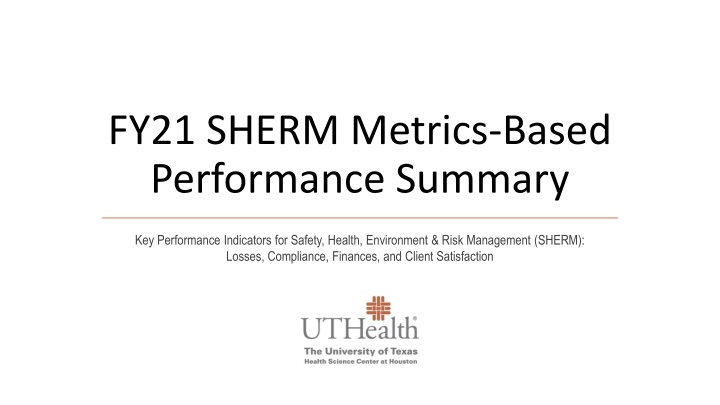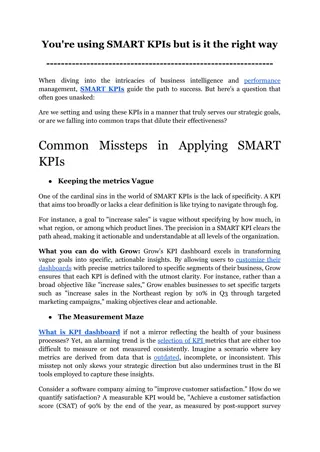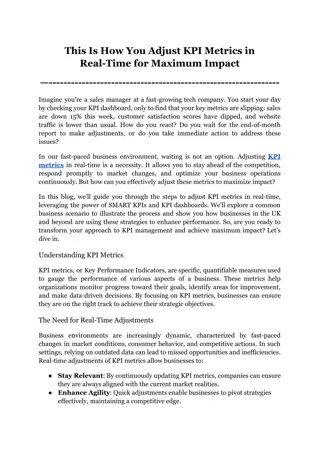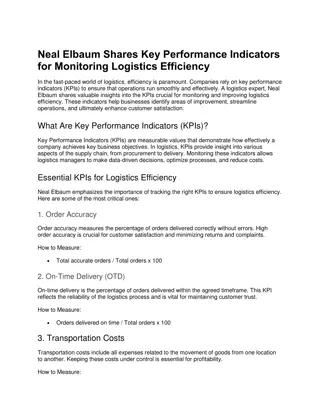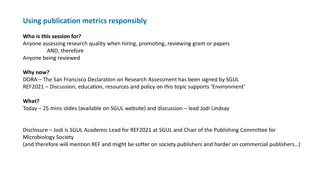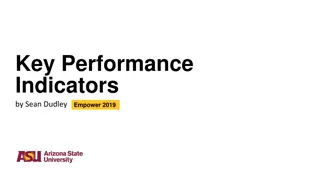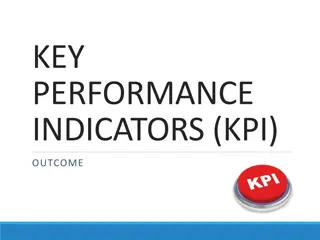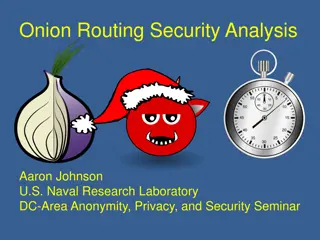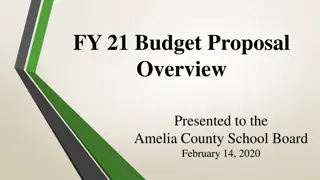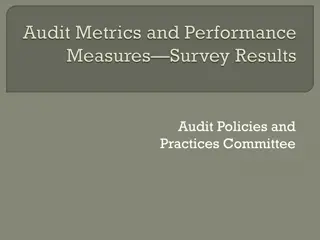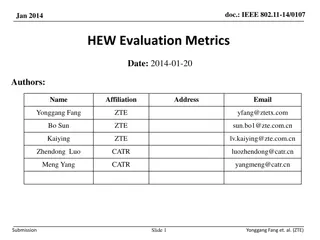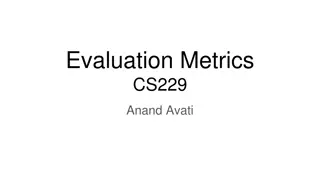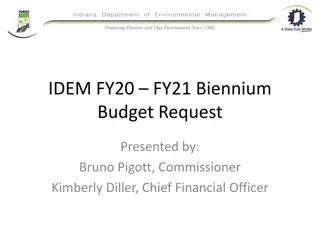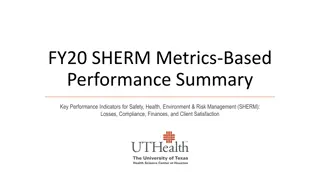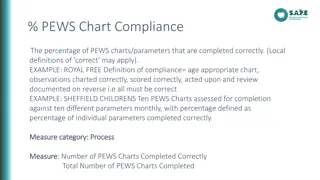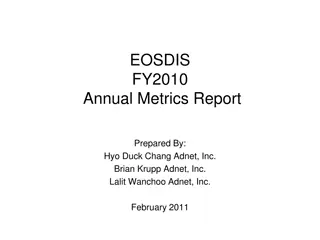FY21 SHERM Metrics-Based Performance Summary KPIs for Safety, Health, Environment & Risk Management
Key performance indicators for safety, health, environment, and risk management in FY21, highlighted with images and insights into UTHealth's institutional missions and SHERM's role. The organizational chart and impacts of the ongoing COVID-19 pandemic on departmental operations are also discussed, including notable services provided during the pandemic.
Uploaded on Feb 27, 2025 | 0 Views
Download Presentation

Please find below an Image/Link to download the presentation.
The content on the website is provided AS IS for your information and personal use only. It may not be sold, licensed, or shared on other websites without obtaining consent from the author.If you encounter any issues during the download, it is possible that the publisher has removed the file from their server.
You are allowed to download the files provided on this website for personal or commercial use, subject to the condition that they are used lawfully. All files are the property of their respective owners.
The content on the website is provided AS IS for your information and personal use only. It may not be sold, licensed, or shared on other websites without obtaining consent from the author.
E N D
Presentation Transcript
FY21 SHERM Metrics-Based Performance Summary Key Performance Indicators for Safety, Health, Environment & Risk Management (SHERM): Losses, Compliance, Finances, and Client Satisfaction
UTHealth Institutional Missions and SHERM s Role, Contributions UTHealth institutional missions: Teaching Research Service Service to the Institution (SHERM s primary role) 4 Key Performance Indicators (KPI) of safety services provided Service to the Community SHERM also contributes to the other key institutional missions as well
SHERM reports to the Executive Vice President & Chief Academic Officer Safety, Health, Environment, & Risk Management Organizational Chart, November 2021 Other Appointments for Vice President Position: Professor of Occupational Health, The University of Texas School of Public Health Division of Epidemiology, Human Genetics and Environmental Sciences Southwest Center for Occupational and Environmental Health Robert Emery, DrPH Vice President SHERM George Delclos, MD, PhD UT Health Services Medical Director
Continued COVID-19 Pandemic Impacts The COVID-19 pandemic has continued throughout FY21, therefore impacts to our departmental operations and services due to COVID-19 are specifically highlighted and addressed in this report Many services continue to be dramatically increased Normal operations and services are being continuously maintained Some services remain reduced or continue to be deferred until a later time period As essential personnel, SHERM staff have remained physically on campus during the entirety of FY21 to serve the institution Despite the continued meritorious dedication and service to the institution, many SHERM staff have been affected personally and professionally by the pandemic. Therefore the health and wellness of our staff has been top priority and will remain so throughout FY22.
Notable SHERM Service During Ongoing Pandemic Support provided for establishment and ongoing maintenance of COVID-19 vaccination hub initially at MSB, Cooley, and eventually UTPB Receipt of all COVID-19 vaccine shipments to secure freezer storage location Safety training provided during fully virtual new employee orientation sessions held by HR Laboratory and clinic safety training courses, while traditionally provided in-person, have been shifted to fully virtual Frequent on site consultations provided for schools, departments, and units returning to campus Training regarding PPE use, particularity for employees and students interacting with patients during ongoing periods of widespread community transmission Professional development and community based training sessions on COVID-19 precautions, vaccinations, etc. Ongoing respiratory fit testing and training for over 4X normal volume of individuals Collaboration with Office of Diversity and Equal Opportunity to evaluate COVID-19 precaution exemption requests Frequent updates to campus signage regarding COVID-19 precautions as changes in precautions occur Implementation of additional housekeeping disinfection and cleaning protocols Participation on grants conducting COVID-19 related research and training (e.g. JETFIT, ECHO) Continued increase in IBC protocol submittals and reviews Provide support for creation of new Texas Epidemic Public Health Institute (TEPHI) and much, much more
SHERMs Four Key Performance Indicators (KPI) for Safety Services to the Institution KPI #2 Compliance With external agencies With internal assessments KPI #1 Losses Personnel Property KPI #3 Finances Expenditures Revenues KPI #4 Client Satisfaction External clients served Internal department staff
KPI #1: Losses Personnel Numbers of first reports of injury submitted by employees, residents, students Number of reported employee injuries and illnesses requiring medical treatment Workers Compensation Insurance experience modifier Property Losses incurred and covered by UTS Comprehensive Property Protection Program Losses incurred but covered by outside party Losses retained by UTHealth
Number of First Reports of Injury, by Population Type, FY01 FY21 (estimated total population = 15,438; employees: 9,827; students: 5,611) 800 Medical Residents transitioned to become Employees Oversight by SHERM 700 NOTE: UTHealth population headcount increased 35% between FY14 to FY21 600 500 Number of First Reports Total n= 419 400 Employees n= 359 300 200 100 Students n= 60 Residents n= 0 0 FY01 FY02 FY03 FY04 FY05 FY06 FY07 FY08 FY09 FY10 FY11 FY12 FY13 FY14 FY15 FY16 FY17 FY18 FY19 FY20 FY21 Fiscal Year
Total Number of Employee First Reports of Injury and Subset of Compensable Claims Submitted to UT System, FY03 to FY21 400 Oversight by SHERM Medical Residents transitioned to become Employees 350 300 Number of reports with no medical claims 250 200 150 Number of reports with medical claims 100 50 0 FY03 FY04 FY05 FY06 FY07 FY08 FY09 FY10 FY11 FY12 FY13 FY14 FY15 FY16 FY17 FY18 FY19 FY20 FY21 *Increase in UTP clinics has resulted in greater risk of injury due to higher clinical injury exposures
Annual UTHealth Incidence Rate of Reported Employee Injuries and Illnesses Compared to National Hospital and University Rates (national data source: US Bureau of Labor Statistics) Annual Reported Injury/Illness Rates 8 7 Injury/Illness Rate per 100 Full Time Workers 6 Hospitals NAICS 622 5 4 3 Universities NAICS 6113 2 1 UTHealth 0 FY07 FY08 FY09 FY10 FY11 FY12 FY13 FY14 FY15 FY16 FY17 FY18 FY19 FY20 FY21
Workers Compensation Insurance Premium Experience Modifier for UT System Health Institutions Fiscal Years 03 to 21 (premium rating based on a three year rolling average as compared to a baseline of 1.00) 0.60 Medical Residents transitioned to become Employees Oversight by SHERM 0.50 0.40 0.30 0.20 UTHSCT (0.163) UTMB (0.120) UTHSCSA (0.104) UTSWMCD (.087) UTHSCH (.064) 0.10 UTMDACC (0.040) 0.00 FY03 FY05 FY07 FY09 FY11 FY13 FY15 FY17 FY19 FY21 Fiscal Year
FY21 Retained Property Losses Retained Loss Cost Summary by Peril Notable Retained Losses (inclusive of insurance deductibles) (Total FY21 retained losses = $1,145,451) Type Location Date Cost Water UPB 12/27/20 $48,500 Mold Water SPH 2/8/21 $47,467 Auto Freeze Various 2/15/21 $692,498 Fire Water SPH 4/28/21 $11,659 Water BBS 5/3/21 $9,150 Water Fire IMM 5/17/21 $58,846 Water HMC 6/1/21 $69,273 Water MSB 6/3/21 $5,309 Water MSB 6/6/21 $9,972 Mold BBS 7/1/21 $9,150 Water CYF 7/15/21 $85,546 TOTAL $1,145,451 Freeze Losses incurred and covered by third party Auto-------------1/2021 $6,484 Losses incurred and covered by UTS insurance Auto---------------12/2020 $7,776 Auto----------------1/2021 $35,649 Auto----------------1/2021 $15,605 Auto----------------8/2021 $5,861
UTHealth Total Property Retained Loss Summary by Peril and Value, FY06 to FY21 $900,000 $800,000 $700,000 Hurricane** $600,000 Freeze $500,000 Lightning/ Fire* $400,000 $300,000 Hurricane $200,000 Water $100,000 $0 FY06FY07FY08FY09FY10FY11FY12FY13FY14FY15FY16FY17FY18FY19FY20FY21 *FY15 Lightning strike caused fire damage at student housing totaling $978K loss, with retained loss total at $417K **FY17 Hurricane Harvey losses totaling $12.6M, with retained loss total estimated at $4.8M
COVID-19 Impacts on Losses Employees, residents, and students testing positive during COVID-19 pandemic impacting their ability to work or learn Each case resulted in needs for contact investigations, disinfection/decontamination of work spaces, and lost work time during quarantine period Total number of Supervisor s First Reports of Injury forms submitted remained low overall during FY21 due to significant number of individuals working or learning remotely Anticipating possible increase in Supervisor s First Reports of Injury submissions due to individuals, departments, and units returning to campus for learning and work activities in FY22
Non-Routine Impacts from Losses Winter Storm Uri brought unprecedented cold weather and snow/ice to the greater Houston area for multiple days in February 2021 Despite best preventative actions, many buildings sustained significant impairments from sustained freezing temperatures primarily fire sprinkler system lines and domestic water lines bursting Over $7 million in property damages across all UT System institutions Retained loss of nearly $700,000 in total property damage sustained at UTHealth
Non-Routine Impacts from Losses Primary SHERM office location within the Cyclotron Building sustained significant water damage from flooding event on July 15, 2021 caused by a faulty valve on chilled water line in mechanical room All EHS personnel residing in this office location were temporarily relocated to swing space in the McGovern Medical School building for a three week time period EHS services were maintained throughout despite these significant disruptions and damage to computers, various EHS equipment, and hazardous waste processing rooms Retained loss of $85,000 in total property damage sustained Preventative actions taken in advance of event, due to flood prone location from named storms, prevented more significant damage (e.g. storing equipment off of floors, etc.)
Non-Routine Impacts from Losses Effective May 2021, the UT System Risk Management Advisory Committee membership agreed to increase the Comprehensive Property Protection Plan (CPPP) insurance deductible from $250K to $500K per occurrence in both the Fire / AOP and Wind / Flood Programs Increase necessary due to extremely challenging insurance market conditions and to ensure long term financial stability of the property insurance plan This is the first increase in deductible in almost 20 years UTHealth will incur greater retained losses for each event and therefore prevention becomes even more paramount
FY22 Planned Actions - Losses Personnel Closely monitor increase in reported employee injury events (largely from the clinic setting) determine root cause and implement preventive measures Evaluate slip, trip, and fall data to determine possible trends or locations; provide interventions to prevent recurrence where possible Continue to focus on transition of medical residents who became employees on July 1, 2019 to contain costs associated with bloodborne pathogens exposures Continue to support individuals as they return to campus during the COVID-19 pandemic situation to ensure health and safety of all campus stakeholders Property Re-emphasize focus on prevention and effective management of property insurance claims given recent increase in deductible from $250K to $500K per occurrence Continue with successful efforts to educate faculty and staff about common perils causing losses (water, power interruption, and theft), simple interventions Develop additional predictive methods for prompt recovery after losses occur, specifically estimated length of time to recovery Continue to refine and improve oversight of UTP property loss prevention, mitigation, and insurance program
KPI #2: Compliance With external agencies Regulatory inspections; other compliance related inspections by outside entities With internal assessments Results of EH&S routine safety surveillance activities
External Agencies Inspections n= 5 Date Agency Findings Status 1 October 27-30, 2020 AAALAC International Suggested expansion of existing waste anesthetic gas monitoring program Completed; ongoing monitoring program in place 2 December 2, 2020 Texas Department of State Health Services Radiation Control No items of non-compliance (UTHealth, Dental Vans at OCB, X-ray R10908, Site 018, Remote) Inspection file closed 3 December 7, 2020 Texas Department of State Health Services Radiation Control No items of non-compliance (UT Physicians, Bayshore Multispecialty, X-ray R26367, Site 039, Unannounced) Inspection file closed 4 August 13, 2021 Texas Department of State Health Services Radiation Control No items on non-compliance (UTHealth, Broad License TMC Campus, License L02774, site 000, radioactive material use) Inspection file closed 5 Inspection file closed August 13, 2021 Texas Department of State Health Services Radiation Control No items on non-compliance (UTHealth, Broad License TMC Campus, License L02774, site 000, physical protection / security)
Non-Routine External Compliance Ensuring normal compliance measures remained in place during COVID- 19 shutdown and ongoing pandemic situation Adjusting operations to meet regulatory compliance variances issued by various regulatory authorities during COVID-19 shutdowns (e.g. oversight of radioactive materials; respiratory protection requirements due to severe global supply shortages such as reuse or reprocessing of protective equipment and temporary exemption from annual fit testing requirements; etc.) Adaptation to new virtual or hybrid format utilized for regulatory inspections in lieu of onsite inspections during the COVID-19 pandemic FY21 inspection frequency resulted in remarkable low number of total inspections, but during FY22 and beyond this should normalize to expected frequencies
Routine Internal Compliance Assessments 5,049 workplace assessments documented (increase from FY20, but still 19% lower than FY19 due to COVID-19 impacts) Progression of routine surveillance program emphasis: labs, clinics, building fire systems, mechanical and non-lab spaces 1,710 deficiencies identified (70% in non-lab spaces) 806 of these deficiencies now corrected to date (represents a decreased efficiency in correcting deficiencies due to challenges of COVID-19 impacts) EHS will continue to focus on assisting with correction of remaining 904 deficiencies Some lab personnel not present onsite to help correct local issues Clinical staff focused on COVID-19 issues and patient care as a priority Working with FPE to track and report progress and reporting progress to appropriate safety committees 9,057 individuals provided with required safety training (increase of 30% compared to pre-COVID-19 conditions) 2,137 individuals trained and fit tested for respiratory protection (decrease from FY20 surge, but still 2X higher than pre-COVID- 19 conditions) Clinical based students (e.g. McGovern Medical School, Cizik School of Nursing, School of Dentistry) provided with COVID-19 awareness and PPE training Continued increase in participation in online safety training modules (primarily refresher lab and clinic safety training) Students accessing online safety training content in lieu of in-person training As a result of software upgrades, there is now improved reporting of online safety training between EHS Assistant and HR Learning Management System (Learn 2 Succeed) 70% of PIs have submitted chemical inventories for filing in SHERM database
Non-Routine Internal Compliance Continued oversight of medical residents who were onboarded as employees in FY20 which included termination of Texas Mutual WCI coverage and switching to UT System WCI oversight Bloodborne pathogens exposures (e.g. needlesticks, etc.) remain most frequent type of injury experienced among this group Water quality testing conducted in all UTHealth building locations following City of Houston water boil event due to Winter Storm Uri to ensure safety of water supply (February 2021) Plan reviews, code compliance, and safety oversight of final TRB major construction projects at UCT, MSB, and SPH; oversight of final JJL renovations; oversight of new Dunn Behavioral Center construction project; design scope planning for TMC3 project
Non-Routine Internal Compliance Ongoing COVID-19 related challenges: Respiratory protection program compliance due to COVID-19 continues to require significant manpower and resources 2,137 individuals fit tested and trained by SHERM during FY21 (under normal circumstances average is 1,200 1,300 individuals) Expedited medical evaluations to ensure fit testing resources needed for Employee Health and Student Health to maintain this service going forward Although UTHealth s supply chain is robust at this time, some NIOSH-approved N95s still very difficult to obtain which creates challenges for some individuals Sourcing and vetting of sufficient PPE remains essential, therefore the PPE and Supply Task Force led by the Office of Procurement continues to meet weekly with SHERM involvement and consultation Requests for return to campus on-site consultations for academic, research, and clinical settings to ensure congruency with COVID-19 protocols to ensure health and safety of all occupants remains high Stress among clinicians and research staff due to ongoing pandemic is significant, and therefore SHERM must remain cognizant and compassionate regarding these factors
FY22 Planned Actions - Compliance External compliance Continue to educate and prepare UTHealth & UTPhysicians clinics about State of Texas Radiation Control program who continue to conduct frequent unannounced x-ray inspections Complete participation in NNSA program to decommission Cesium irradiators (X-ray irradiator alternative was purchased and installed in FY21 as part of this project) Provide oversight of proposed withdrawal from Federal Select Agent program due to impending retirement of key faculty Assist with the implementation of the new CMS and Federal Executive Order 14042 requirements for workplace safety protocols to protect individuals from COVID-19 Internal compliance Develop efficiencies and strategy for long term management of respiratory protection program since demand remains high Continue aggressive routine surveillance program. Incorporate lessons learned from deficiency data into safety training to prevent recurrence. Focus on education of research and clinic personnel regarding controlled substances used and stored at UTHealth and UTP Continue to work with FPE to systematically address identified deficiencies and support current projects to address fire safety considerations Provide regular updates to appropriate safety committees Continue emphasis on lab inventories of hazardous materials Chemical inventories already a requirement Support biosafety awareness and inventory of biological agents and toxins within UTHealth laboratories
KPI #3: Finances Expenditures Program cost, cost drivers Revenues Sources of revenue, amounts
Campus Square Footage, SHERM Resource Needs and Funding (modeling not inclusive of resources provided for, or necessary for Employee Health Clinical Services Agreement) Total Assignable Square Footage and Research Subset Modeled SHERM Resource Needs and Institutional Allocations 5000000 $4,000,000 Research area (sf) 4500000 Amount Not Funded $3,500,000 4000000 $3,000,000 3500000 3000000 $2,500,000 Institutional Allocation 2500000 $2,000,000 2000000 $1,500,000 1500000 $1,000,000 Non- research area (sf) WCI RAP Rebate 1000000 $500,000 500000 Contracts & Training 0 $0 FY14 FY15 FY16 FY17 FY18 FY19 FY20 FY21 FY14 FY15 FY16 FY17 FY18 FY19 FY20 FY21 Note: TNASF reported in FY18 & FY19 reduced due to accounting adjustment by FPE Source: FPE, Space Management
Annual Hazardous Wastes Volumes Generated (in pounds) (inclusive of all Hazardous Biological, Chemical, and Radioactive Waste Streams) Pounds *Note: Increase in radioactive wastes in FY19 related to compulsory decommissioning of cyclotron unit
Hazardous Waste Cost Obligation and Actual Disposal Expenditures (Inclusive of Biological, Chemical, and Radioactive Wastes) Note: Increase in hazardous waste costs in FY19 related to compulsory decommissioning of cyclotron unit FY21 savings: $132,558
FY21 Revenues Service contracts UT Physicians $800,000 Note: Previous SHERM safety services contract for UTPhysicians was folded into the UTHealth/UTPhysicians MOU on Sept 1, 2020 at a rate of $800,000 per year. This amount includes $137,800 for Occupational Health Program. Continuing education courses/outreach Training, honoraria, peer reviews, and fit testing for non-UTHealth personnel $12,964 SHERM staff salary offsets from various research grants $20,545 Total $833,509 NOTE: Above equates to 25% of total SHERM budget for FY21
Safety Support for UT Physicians UTHealth / UTPhysicians MOU Discontinued SHERM Professional Services Agreement and transitioned to UTHealth / UTPhysicians MOU at the request of UTHealth leadership on Sept 1, 2020 Combination of safety, insurance, and occupational health services under one contract Current rate is now $800,000 annually for all services combined Agreement includes services such as training, radiation safety permitting & surveys, general clinic surveys, fire & life safety surveillance, waste management, emergency preparedness & response, IAQ evaluations, asbestos/mold monitoring, accident/incident investigations, CAP/CLIA quality control monitoring, etc. Recent activities Added 1 FTE in Hospital & Clinic Safety Program to primarily assist with CAP/CLIA oversight and compliance, respiratory fit testing for clinicians, clinical safety surveys, etc. 1 FTE planned for Risk Management & Insurance Program to primarily assist with additional responsibilities related to loss prevention and insurance oversight for UTP, as well as to bolster emergency preparedness and management Challenges Continued growth and change of clinical locations and services Tracking and managing all locations with radiation producing devices Emergency management for UTP clinics in different geographic locations (spanning an area roughly the size of the state of Connecticut)
Current UTHealth / UTPhysicians Clinical Footprint UTPhysicians Clinics: UTP clinic locations (n=118) UTP timeshare locations (currently ~30) UTHealth Clinics: UT Health Services Clinic (Employees and Medical Residents) UT Student Health Services Clinic SOD dental clinics (n=4) Neurosciences (n=15) WIC clinics (n=6) Harris County Psychiatric Center + Dunn Behavioral Science Center
FY22 Planned Actions - Financial Expenditures Continue aggressive hazardous waste minimization program to contain hazardous waste disposal costs Focus on regulated medical waste generation reduction in labs and clinics due to 30% increase experienced during recent (Sept 1, 2019) renewal of UT System-wide contract Fees increase significantly each fiscal year for each point of collection, so primary focus is on minimizing volumes and maximizing efficiency to reduce stop frequencies Continue to lobby for dedicated funding for Occupational Health Clinical Services Agreement because of impending discontinuance of UTS WCI RAP Revenues UTHealth / UTPhysicians MOU now includes occupational health allocation of $138,700 Continue with service contracts and community outreach activities that provide financial support to supplement institutional funding, including enhancing virtual training capabilities Continue to participate in various research grant projects which allow for staff salary offsets Continued receipt of WCI RAP fund allocations in FY21 ($160,721), but program may terminate at any point
FY22 Challenges - Financial Current Financial Challenges Continued support for high number of individuals participating in respiratory protection program due to COVID-19 Fit testing and training; sourcing of N95s and other PPE appropriate to protect workers and students from COVID-19 exposure Continued increases in retained loss medical expenses due to transition of UT Medical Foundation residents to UT System workers compensation policy upon becoming UTHealth employees Increase in property insurance deductible from $250K to $500K Additional manpower needs to support continued clinical growth planned additional FTE in FY22 to serve Dunn Behavioral Health Center once completed Current shortfall in funding for Occupational Health Program $450,000+ currently necessary to run program, increases anticipated due to recent medical resident transition WCI RAP funds being used to support program, but these funds may not be issued again in future $138,700 now coming from UTHealth / UTPhysicians MOU to help support Occupational Health Program
KPI #4: Client Satisfaction External clients served Results of Client Satisfaction Survey for Animal Care department Internal department staff Summary of ongoing staff professional development activities
Client Feedback Focused assessment of a designated program aspect performed annually: FY03 Clients of Radiation Safety Program FY04 Overall Client Expectations and Fulfillment of Expectations FY05 Clients of Chemical Safety Program Services FY06 Clients of SHERM Administrative Support Staff Services FY07 Feedback from Employees and Supervisors Reporting Injuries FY08 Clients of Environmental Protection Program Services FY09 DMO/ASL Awareness Survey of Level of Informed Risk FY10 Clients of Biological Safety Program Services FY11 Feedback on new UTHealth Alert emergency notification system FY13 Clients of HCPC Safety Program Services FY14 Student Perception Survey question regarding safety program FY15 Clients of Occupational Safety & Fire Prevention program services FY16 Clients of HCPC Safety Program Services (re-evaluation of services since 2013 implementation) FY17 Area Safety Liaisons FY18 Clients of UTPhysicians Safety Program Services FY19 UTHealth Safety Committee Members (Institutional Biosafety, Chemical Safety, & Radiation Safety Committees) FY20 UT Police at Houston FY21 Center for Animal Medicine and Care
Internal Department Staff Satisfaction Continued support of ongoing academic pursuits leverage unique linkage with UT SPH for both staff development and research projects that benefit the institution Weekly continuing education sessions on a wide variety of topics conducted continuously via virtual format during COVID-19 Safety Geek of the Week staff recognition award for superior service delivery Participation in the delivery of UT SPH continuing education course offerings Participation in various UT SPH academic courses Adjunct academic appointments in UT SPH EOHS department for doctorally-prepared staff (n=4) Participation on several health and safety related grants through UT SPH Membership, participation in professional organizations Annual conduct of SHERM Mentoring Day where any interested staff member can meet with the VP SHERM to discuss professional development plans and seek advice, suggestions
FY22 Planned Actions Client Satisfaction External Clients Continue with customer service approach to operations Collect data for meaningful benchmarking to compare safety program staffing, resourcing, and outcomes Interface with Student Services will be focus for FY22 survey Internal Clients (departmental staff) Continue with routine professional development seminars Special focus on emerging issues: safety culture, insider threats, change management, technology in safety (digital safety), total worker health, cultural intelligence, communications, establishing relationships, understanding the exposome Continue with involvement in training courses and outreach activities continued focus on cross training Continue mentoring sessions on academic activities Continue 360o evaluations on supervisors to garner feedback from staff
Institutional Safety Service KPI Caveats Important to remember what isn t effectively captured by these metrics: Increasing complexity of research projects supported Increased collaborations and associated challenges Increased complexity of regulatory environment Impacts of construction both navigation and reviews The pain, suffering, apprehension associated with any injury every dot on the graph is a person The things that didn t happen
SHERM Contribution to the Community Service Institutional Mission Safety, insurance, and occupational health support to UT Physicians clinical operations Staff membership on local safety committees: Delivery of professional continuing education courses through UT SPH Institutional Biosafety Committees (Rice University; University of Houston Downtown ) Radiation Safety Committees (Memorial Hermann Hospital) Participation in the leadership and management of professional associations by SHERM staff members American Biological Safety Association International Inclusive of peer reviewed journal (Applied Biosafety) Editorial Board Southern Biosafety Association (local affiliate of ABSA - International) State of Texas Chapter of the Health Physics Society American Academy of Health Physics Outreach education through invited lectures provided to local and national professional organizations Provision of subject matter expert interviews on safety-related topics to local and national media
SHERM Contribution to the Teaching Institutional Mission UT SPH academic instruction, student advising Several SHERM employees serve in adjunct faculty positions at SPH Guest lectures at other UTHealth schools (UT MS and GSBS) and other area institutions (TAMU, TWU, TSU, UHCL, UHD) Host student internships, practica. Advising for UT MS Scholarly Concentration students Continuing education courses through UT SPH Outreach education through courses with professional organizations (HPS, ABSA, CSHEMA, Eagleson Institute)
SHERM Contribution to the Research Institutional Mission NIEHS training grant and Ebola supplement (w/Dr. Rios, UT SPH) NIOSH evaluation of elastomeric respirators in the healthcare setting grant (w/ Dr. Pompeii, Baylor College of Medicine) Participation in other funded grants: NIOSH ERC SWCOEH TSU Health Physics Program - $11,000 COVID-19 related research collaborations: Dr. Amber Luong evaluating decontamination methods for N95 respirators Dr. Mary (Cindy) Farach Carson evaluating novel N95 respirator product Memorial Hermann Hospital N95 reprocessing center validation and management Advising and hosting students for research projects and associated publications: Zapata JR, Stewart J, Kelly KO, Taylor AR, Martinez EI, Amoako K, Gutierrez JM, EMERY RJ, Cheng SY, Patlovich SJ, Harvey MC. A cyclotron decommissioning radiological assessment exercise performed by student mentees underrepresented in the radiation safety profession. Health Phys,120(1): 105-111, 2021 King KG*, Delclos GL, Brown EL, Emery ST, Yamal JM, EMERY RJ. An assessment of outpatient clinic room ventilation systems and possible relationship to disease transmission. Am J Infect Control. 2021 Jan 21: S0196- 6553(21)00023-7. doi: 10.1016/j.ajic.2021.01.011. Laine J*, Delclos G, EMERY RJ, Peskin, M. The prevalence of practicing safety professionals knowledge and involvement with workplace wellness programs, Prof Saf submitted August 2021. Jiang, Z.Y., Huang, Z., Schmale, I., Brown, E.L., Lorenz, M.C., Patlovich, S.J., Goswami, K., Wilson, H.B., Ahmad, J., Alexander, R., Bryan, W., Burke, L., Citardi, M.J., Elias, J., Ho, T., Jacob, J., Low, G., Miram n, P., Patki, A.U., Yao, W.C., Luong, A.U. N95 respirator reuse, decontamination methods, and microbial burden: A randomized controlled trial, American Journal of Otolaryngology, 2021, https://doi.org/10.1016/j.amjoto.2021.103017 Melchor, M., Sedlock, E., Patlovich, S.J. Providing Safe Dental Care During COVID-19: A Review of the Risk Assessment and Controls Implemented at The University of Texas School of Dentistry at Houston. Journal of Dental Infection Control and Safety, Volume 3, 2021.
Summary Various measures and metrics indicate that SHERM continues to meet its objective of maintaining a safe and healthy working and learning environment in a cost effective manner that doesn t interfere with operations, while also making active contributions to the institutional missions: Injury rates continue to be among the lowest within the UT System Despite continued growth in the research enterprise, hazardous waste costs aggressively contained Client satisfaction continues to be measurably high And while providing these services, SHERM also actively contributes to the teaching, research, and community service missions of the institution The major area of current institutional growth is in the clinical setting, so SHERM will need to adjust accordingly to support this enterprises The impending discontinuance of the UTS WCI Resource Allocation Program represents a challenge, especially for the Occupational Health program A successful safety program is largely people powered the services most valued by clients cannot be automated! SHERM resource needs will continue to be driven primarily by the square footage to which services are provided (total, lab and clinic square footage) and geographic distribution
